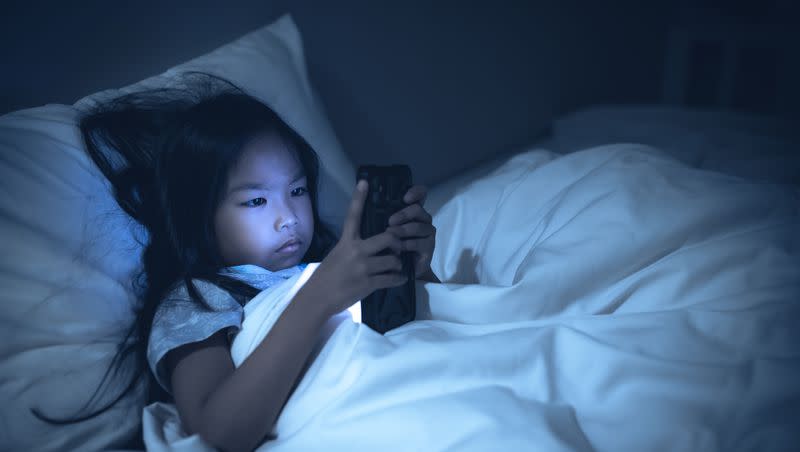Opinion: We protect children in the physical world — why not the digital world?

Every year, more than 5,000 young Americans take their own lives. Our nation’s young people are facing an unprecedented mental health crisis, and the preponderance of the evidence that links this tragic trend to social media is beyond disturbing enough to warrant action.
That’s why we support dual legislation — at both the state and federal levels — to protect our children from the harms of social media.
More than 40% of teenagers say that they struggle with feelings of sadness or hopelessness, and more than half of parents express concern over their children’s mental well-being. There has never been a generation this depressed, anxious and suicidal, and growing evidence is showing that social media is causing harm, especially for teen girls.
Research conducted by the University of Utah Huntsman Mental Health Institute shows that young adults who use social media are three times as likely to suffer from depression. And when we look at what happened to American teens from 2009-2010, as social media became more prevalent, this reality is undeniable.
In 2010, about 63% of American high-school students reported using a “social networking site” on a daily basis. But by 2014, 80% of high-school students said they used a social media platform daily, and 24% said they were online “almost constantly.”
Related
During that timeframe, hospital admissions for self-harm doubled for girls ages 10 to 14. That is no coincidence.
There is also eyewitness testimony that speaks to this very point. In 2017, British researchers asked 1,500 teens to rate how each of the major social media platforms affected their anxiety, loneliness, body image and sleep. Instagram scored as the most harmful, followed by Snapchat and then Facebook.
If you still don’t believe us, take Facebook’s own word for it. An internal Facebook presentation noted, “We make body image issues worse for one in three teen girls. … Teens blame Instagram for increases in the rate of anxiety and depression. This reaction was unprompted and consistent across all groups.”
Facebook’s own research also stated, “The tendency to share only the best moments, a pressure to look perfect and an addictive product can send teens spiraling toward eating disorders, an unhealthy sense of their own bodies and depression.”
Related
Perspective: Please don’t call me skinny — my experience recovering from an eating disorder
Perspective: Our teenage girls are suffering. Utah can lead the way in helping them
This effect is particularly relevant to TikTok, a platform which is known for addictive algorithms. And this should come as no surprise, as the platform was developed by the Chinese Communist Party for the very purpose of creating a digital, emotional heroin for young people in the West.
It’s also worth noting that social media usage is becoming more and more common among younger and younger audiences. In 2021, children ages 8 to 12 spent five and a half hours a day on screens, and teens ages 13 to 18 spent nearly nine hours a day. These statistics should scare us all, but they should also inspire us to make bold, necessary change for the sake of our kids.
President Joe Biden recently wrote that “… young people are struggling with bullying, violence, trauma and mental health. We must hold social-media companies accountable for the experiment they are running on our children for profit.” And the Surgeon General recently stated that 13 is “too early” for children to join social media.
We couldn’t agree more.
Utah recently passed two social media bills which will provide protection for our children, more parental controls, and increased accountability for social media companies.
On the federal side, this critical issue is a real opportunity for bipartisanship in a divided Congress, and it’s an important opportunity for progress in a divided nation.
To those who say this would be an overstep by our government, we understand your concern. And we share your ideological belief that more government usually makes life worse, not better.
But the government already regulates this aspect of our digital lives. The current minimum age for social media usage is 13. Obviously, this law is not enforced by tech companies and, subsequently, easily avoided by kids who want to participate. Federal legislation will not only raise that minimum age but hold tech companies accountable for enforcing this regulation.
Related
How do you know if you’re addicted to TikTok? Here are the signs
Should children under 16 be denied access to social media apps?
We have countless protections for our children in the physical world — we require car seats and seat belts; we have fences around pools; we have a minimum drinking age of 21; and we have a minimum driving age of 16.
The damage to Generation Z from social media is undeniable — so why are there no protections in the digital world? This is about taking power from companies and giving it to parents in the interest of their kids, not the government.
We are under no illusion that this is a silver bullet solution for what has become a national crisis. But we certainly believe that it’s an important step in the right direction. We hope you’ll join us in working to give our nation’s young people the protections they so desperately need.
The 988 Suicide & Crisis Lifeline provides free and confidential support for anyone experiencing a suicidal, mental health, and/or substance use crisis. Please call or text 9-8-8 to be connected with a trained crisis counselor.
Please visit stewart.house.gov for more information on the Social Media Child Protection Act.
Gov. Spencer Cox is the 18th governor of the state of Utah. Chris Stewart represents Utah’s second district in the U.S. House of Representatives.

